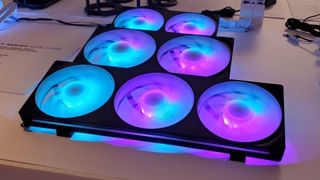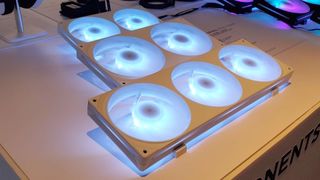NZXT's doing something that makes so much damned sense I don't know why it's not been done before
Yet there are still niggling fears of being first to market with something no-one has done before.

NZXT is doing something new with PC case fans, something no-one is doing, and that seems to be as exciting for the company as it is terrifying. "In the fan market, there's a lot of talk of magnetic fans and fans that are clickable together," CEO Johnny Hou tells me. "So we're like, well, if you really want, if you really care about the fans being connected, why don't we just make them all together?"
If you look around at the likes of Lian Li, Corsair, Thermaltake, and MSI, all of them are creating new case fan systems that link several fans together to make up a solid lump of spinning airflow. It's useful for mounting on AIO water coolers, or big front panels of chassis, or basically anywhere you need more than one 120mm fan.
And it makes sense. You take away the hassle of extra cabling, because the magnetic connections often also carry power through to the next one in a daisy chain, and it makes them more straightforward to install into your PC. Win, win. But you do still need to screw in each corner of each fan or you could have the middle of a three, for example, flopping out and breaking the connection, powering down those either side. And you don't want that.
But what if there was a better way? Like manufacturing them so that you had the common configurations of fans already in one block? Which is exactly what NZXT is doing with its F Series RGB Core fans: It's manufacturing single, dual, and triple fan arrays, and multiple different sizes (240, 280, and 360mm), to cater to all sorts of cases and coolers. And they all need the same number of screws: Four.
"If you think about it," says Hou, "like first of all, there are a lot of costs in those magnets and connectors, and you still have to connect them up. You still have screws you have to do.
"The issue is that in the fan market, basically zero percent of the fans are unibody. So we are putting it on all our cases and everything. So internally there was a lot of—and there still is—a lot of concern. Oh, no-one's doing this. Is this going to be okay, you know?"

The self-doubt is endearing, and honestly it feels like partly because when you see it, it makes so much damned sense. It feels like the, sadly mythical, tale of NASA spending a ton of cash developing a space pen when the Russians simply took pencils, where the other fan makers are over-engineering the problem while NZXT is just making bigger frames.
The biggest gaming news, reviews and hardware deals
Keep up to date with the most important stories and the best deals, as picked by the PC Gamer team.
It's so sensible that part of you thinks, well, if no-one else is doing it, maybe there's something we just haven't thought of.
"But when we run surveys," Hou says, "when we talk to users, they're like, it makes total sense. Yeah, why not? If the quality is good, performance is the same, the price is fair, why not?
"So, if a year from now, the industry moves to unibody then I would say like that, that would be one thing I'd be really proud of, because I think it's pushing the industry in the right direction, you know, and making it a better consumer experience."

Until that moment happens, the product Hou is the most proud of is NZXT's classic H440 chassis. It was the first ever PC case to ditch the 5.25-inch bay. For young people reading this, mummy and daddy used to use physical media to install Windows and games on their PCs. They'd use a CD-ROM drive, and if they were fancy, a DVD drive, and if they were really fancy, a Blu-Ray drive.
And if they were idiots, a HD-DVD drive.
Those are the things which filled up the last 5.25-inch bays of a PC. There were other things, like cup-holders and cigarette lighters, but those were the main uses. But then always-connected internet happened, and installing Windows from USB sticks, and downloading games from Steam. So, NZXT decided to get rid, and in doing so freed up a ton of space inside the new case.
And everyone lost their collective faeces.
"Distributors were like, wait, how do people install Windows?" says Hou. "At that moment, it was such a controversial decision. And early on that case didn't sell well—for like six months—because people were weirded out by seeing a computer case without a five and a quarter inch drive bay."
And now you will struggle to find a single PC case that isn't some dedicated media chassis to include a 5.25-inch bay. Certainly no gaming PC would be seen dead with one.
"So that's a great example of something that I feel very proud of. We've in some way made the industry consider doing something different that maybe it wouldn't have done if we hadn't taken a risk."
Catch up with Computex 2024: We're on the ground at Taiwan's biggest tech show to see what Nvidia, AMD, Intel, Asus, Gigabyte, MSI and more have to show.

Dave has been gaming since the days of Zaxxon and Lady Bug on the Colecovision, and code books for the Commodore Vic 20 (Death Race 2000!). He built his first gaming PC at the tender age of 16, and finally finished bug-fixing the Cyrix-based system around a year later. When he dropped it out of the window. He first started writing for Official PlayStation Magazine and Xbox World many decades ago, then moved onto PC Format full-time, then PC Gamer, TechRadar, and T3 among others. Now he's back, writing about the nightmarish graphics card market, CPUs with more cores than sense, gaming laptops hotter than the sun, and SSDs more capacious than a Cybertruck.
Most Popular






